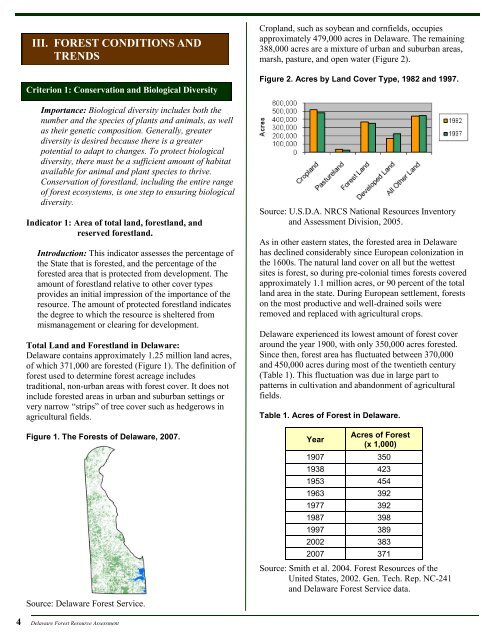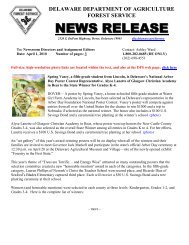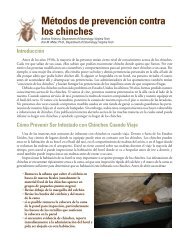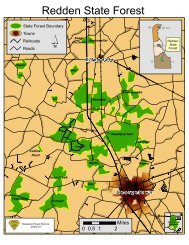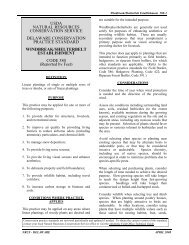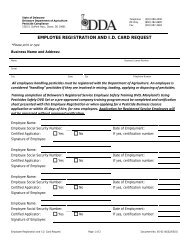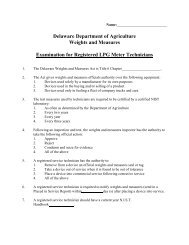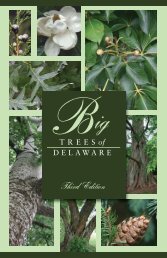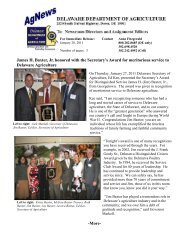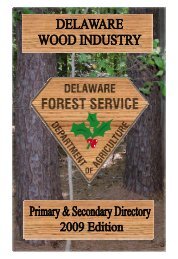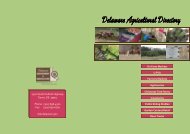DFS Resource Assessment - Delaware Department of Agriculture
DFS Resource Assessment - Delaware Department of Agriculture
DFS Resource Assessment - Delaware Department of Agriculture
You also want an ePaper? Increase the reach of your titles
YUMPU automatically turns print PDFs into web optimized ePapers that Google loves.
III. FOREST CONDITIONS AND<br />
TRENDS<br />
Criterion 1: Conservation and Biological Diversity<br />
Importance: Biological diversity includes both the<br />
number and the species <strong>of</strong> plants and animals, as well<br />
as their genetic composition. Generally, greater<br />
diversity is desired because there is a greater<br />
potential to adapt to changes. To protect biological<br />
diversity, there must be a sufficient amount <strong>of</strong> habitat<br />
available for animal and plant species to thrive.<br />
Conservation <strong>of</strong> forestland, including the entire range<br />
<strong>of</strong> forest ecosystems, is one step to ensuring biological<br />
diversity.<br />
Indicator 1: Area <strong>of</strong> total land, forestland, and<br />
reserved forestland.<br />
Introduction: This indicator assesses the percentage <strong>of</strong><br />
the State that is forested, and the percentage <strong>of</strong> the<br />
forested area that is protected from development. The<br />
amount <strong>of</strong> forestland relative to other cover types<br />
provides an initial impression <strong>of</strong> the importance <strong>of</strong> the<br />
resource. The amount <strong>of</strong> protected forestland indicates<br />
the degree to which the resource is sheltered from<br />
mismanagement or clearing for development.<br />
Total Land and Forestland in <strong>Delaware</strong>:<br />
<strong>Delaware</strong> contains approximately 1.25 million land acres,<br />
<strong>of</strong> which 371,000 are forested (Figure 1). The definition <strong>of</strong><br />
forest used to determine forest acreage includes<br />
traditional, non-urban areas with forest cover. It does not<br />
include forested areas in urban and suburban settings or<br />
very narrow “strips” <strong>of</strong> tree cover such as hedgerows in<br />
agricultural fields.<br />
Figure 1. The Forests <strong>of</strong> <strong>Delaware</strong>, 2007.<br />
Source: <strong>Delaware</strong> Forest Service.<br />
Cropland, such as soybean and cornfields, occupies<br />
approximately 479,000 acres in <strong>Delaware</strong>. The remaining<br />
388,000 acres are a mixture <strong>of</strong> urban and suburban areas,<br />
marsh, pasture, and open water (Figure 2).<br />
Figure 2. Acres by Land Cover Type, 1982 and 1997.<br />
Source: U.S.D.A. NRCS National <strong>Resource</strong>s Inventory<br />
and <strong>Assessment</strong> Division, 2005.<br />
As in other eastern states, the forested area in <strong>Delaware</strong><br />
has declined considerably since European colonization in<br />
the 1600s. The natural land cover on all but the wettest<br />
sites is forest, so during pre-colonial times forests covered<br />
approximately 1.1 million acres, or 90 percent <strong>of</strong> the total<br />
land area in the state. During European settlement, forests<br />
on the most productive and well-drained soils were<br />
removed and replaced with agricultural crops.<br />
<strong>Delaware</strong> experienced its lowest amount <strong>of</strong> forest cover<br />
around the year 1900, with only 350,000 acres forested.<br />
Since then, forest area has fluctuated between 370,000<br />
and 450,000 acres during most <strong>of</strong> the twentieth century<br />
(Table 1). This fluctuation was due in large part to<br />
patterns in cultivation and abandonment <strong>of</strong> agricultural<br />
fields.<br />
Table 1. Acres <strong>of</strong> Forest in <strong>Delaware</strong>.<br />
Year<br />
Acres <strong>of</strong> Forest<br />
(x 1,000)<br />
1907 350<br />
1938 423<br />
1953 454<br />
1963 392<br />
1977 392<br />
1987 398<br />
1997 389<br />
2002 383<br />
2007 371<br />
Source: Smith et al. 2004. Forest <strong>Resource</strong>s <strong>of</strong> the<br />
United States, 2002. Gen. Tech. Rep. NC-241<br />
and <strong>Delaware</strong> Forest Service data.<br />
4 <strong>Delaware</strong> Forest <strong>Resource</strong> <strong>Assessment</strong>


